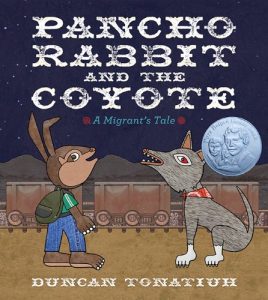


In both prose and art, Tonatiuh expertly balances folkloric elements with stark, modern realities Pancho Rabbit's trip has the feel of a classic fable or fairy tale, with the untrustworthy coyote demanding more and more of him. When Pancho goes in search of his father, he meets a coyote who agrees to guide him north. It is time for Papa Rabbit to return home from working in "El Norte," and his family prepares a celebratory fiesta, but he fails to arrive. Tonatiuh (Diego Rivera: His World and Ours) uses an animal cast to create a valuable portrait of the often-perilous journeys of migrant Mexicans who seek work in the U.S. Reynolds, Annapolis Valley Regional Library, Bridgetown, NS, Canada Copyright 2013 School Library Journal, LLC Used with permission. Classrooms studying the migrant experience will find plenty to discuss here.- Angela J. The book shows the fragility of making a living, the desperation that many migrants experience, and the deep family ties that bind the characters. The stylized, flat illustrations put the story in context and set the mood. Children will learn a bit about Mexican culture from the hand-drawn and digitally collaged folk-art-inspired illustrations depicted in warm desert colors as well as from the author's note. Animals stand in for people in this morality play about immigration, allowing readers to see the migrant's side of the story. When the mole, beans, and tortillas are gone, and they have finally crossed the big wall, Coyote is about to eat Pancho when Papa and his friends come to his rescue. He runs into Senor Coyote, who offers to help, but demands that Pancho give him the food he is carrying. Tonatiuh's fable also changed the way many students viewed the immigrant groups whom they were studying.K-Gr 2-When Papa Rabbit does not return from the lettuce and carrot fields of El Norte, Pancho Rabbit sneaks off in the night to search for him. Students cared about the topic, grappled with some of the complexities, and had much to say.

Following these interviews, the class studied eras of immigration and some of the laws that governed immigration. At the outset of a unit of study on 19th and 20th century immigration to the United States, students interviewed family members and neighbors who had immigrated to this country. The story is an allegory of the migration of Mexicans seeking passage to the United States and the smugglers, or Coyotes, who prey upon them. Author and illustrator Duncan Tonatiuh relates a rabbit family's struggle to find a better way of life. As Chip Wood, an expert on child development, observed, nine-year-olds are often "struggling with the cognitive task of understanding ethical behavior at a new level." One of this author's goals was to help his students observe and then "think deeply" as a first step in getting them to "act in ways that promote the common good." With this in mind, he selected the picture book "Pancho Rabbit and the Coyote: A Migrant's Tale" (a Notable Social Studies Trade Book for Young People in 2014) to read with his students to enhance the study of immigration, bringing a current issue into their discussions. Students' observations about society often become the basis for class discussions in Peter Cipparone's fourth-grade classroom.


 0 kommentar(er)
0 kommentar(er)
